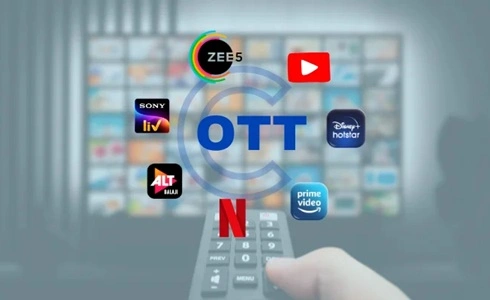Over-the-top (OTT) platforms offer video and audio content directly to users through the internet without the need for traditional cable or satellite TV. These platforms are popular among the new generations, like millennials and Gen Z, for their broad variety of movies, series, and shows. Some notable names are Netflix, Disney Hotstar, and Amazon Prime Video in India. These are some of the video streaming OTT platforms.
Similarly, there are audio streaming OTT platforms out there like Spotify and YouTube Music. These platforms usually have millions of subscribers for movies, series, live sports, music, and more on-demand content. This industry penetrated the market due to increasing smartphone use, better internet access, and changing consumer habits. Key advantages most users claim are affordable pricing and the convenience of watching favourite shows on demand.
Financially, the OTT platform industry is a multi-billion-dollar industry worldwide that generates revenue from subscriptions, in-app advertisements, rentals, and more.

How is the OTT Business Model Structured?
OTT platforms operate as content streaming services where they acquire or create content like movies, series, documentaries, music, or live sports. Then this content is delivered to users through apps and websites. There is no need for cable distributors, and customers can access their favorite content through the internet, which means viewers can stream their favourite content anytime.
To run an OTT platform, the infrastructure investment is enormous; platforms need cloud servers, content delivery networks, apps for different devices, and a secure payment gateway. Similarly, there is a huge revenue potential where multiple strategies are used to board new users while keeping the existing ones hooked to subscription plans.
| Industry | OTT Streaming (Video & Audio) |
| Global Market Size 2025 | ~US $ 480 billion (estimated) |
| Key Global Players | Netflix, Amazon Prime Video, Disney+, Hulu, Spotify, Apple TV+, YouTube Premium |
| Major Indian Players | JioCinema, Disney+ Hotstar, Zee5, SonyLIV, MX Player |
| Average Revenue Model Types | SVOD, AVOD, TVOD, Hybrid |
| Projected CAGR (2025-2030) | ~14% worldwide |
How Do OTT Platforms Make Money?
The OTT industry often relies on multiple revenue streams to ensure they are able to afford infrastructure expenses and generate revenue. The key strategies that most OTT platforms are currently using are as follows –
1. Subscription Video on Demand (SVOD)
Subscription video on demand is the widely preferred method by most streaming platforms like Netflix, Disney+ +, Amazon Prime Video, etc. Users have to pay a recurring monthly or yearly fee to access the unlimited content. There are multiple plans with a ladder strategy for upselling. One can consider getting an individual plan, a family plan, and more. Meanwhile, there are streaming quality options as well that cost slightly more for UHD or 4K qualities.
2. Advertising Video on Demand (AVOD)
AVOD or Advertising Video on Demand plan offers free-to-watch content, but the platform makes revenue through advertisements shown in between. There are banner ads, video ads, pop-up ads, and so on.
3. Hybrid Model (Freemium)
Hybrid is a smart strategy for customers who don’t want to buy a subscription plan or want to get the plan at an affordable price. In the Hybrid plan, users can watch their favourite show for free or for a small monthly fee, but there are ads in the show, like traditional TV. Common examples are YouTube, Amazon Prime, and Hotstar.
4. Transactional Video on Demand (TVOD)
TVOD, or transactional video on demand, is a feature for watching individual movies or events where users pay for the content they want to watch. In this strategy, users also get the feature to rent a movie, show, or event. By this, users don’t have to buy a whole subscription plan. Some popular examples are Apple iTunes, Google TV, or sports pay-per-view services.
5. Original Content Licensing and Syndication
Successful platforms produce original shows and movies. After exclusive streaming, they license this content to TV networks or other platforms worldwide, earning additional revenue. Netflix and Disney both sell distribution rights to expand earnings.
Financial Performance
The OTT industry generated around US$480 billion in revenue globally in 2025, and it is growing rapidly in the Asia-Pacific region. Subscription-based platforms like Netflix reported annual revenue exceeding US $ 44 billion in 2025, whereas ad-supported platforms like YouTube generated more than US $ 10 billion through advertising. The OTT market value in India is approximated to be about ₹17,000 crores or US $ 2 billion.
What’s New in 2025?
Ad-supported tiers have helped many platforms gain new customers and make revenue from them. Due to this reason, many premium platforms like Netflix and Disney+ have launched lower-cost ad-supported plans to price-sensitive markets. Moreover, OTT platforms are using AI-driven personalization to optimize show recommendations, Ad placement, and manage streaming quality more efficiently. In India, regional language content is becoming the key growth driver, and more streaming platforms are bringing exclusive shows.



